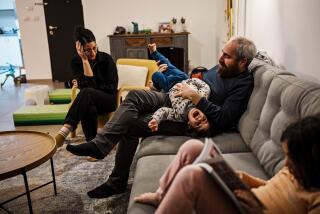For devout Jews, a zone of privacy in the <i>sheitel</i>
- Share via
Shternie Lipskier’s is a stylish, deep red bob with short bangs. Elana Kornfeld’s is a long, dark, glossy brunette that she parts on the side. Chani Wuensch’s is a lighter brunette, with auburn lowlights and graduated bangs that fall softly across her brow. Chicly dressed and ranging in age from 29 to 36, the three are discussing their hair, or more specifically their sheitels.
Sheitels are the wigs that married Orthodox Jewish women of the most devout, or Hasidic, communities wear in public. It would be a surprise to the other patrons of the Studio City coffee shop where we’ve met that the women’s hair is not their own and that not so much as a strand of their real hair is visible.
Wuensch is a sheitel macher, or wig expert. Kornfeld, who is Wuensch’s sister, and Lipskier are both married to Chabad Lubovitch rabbis.
Covering their hair is part of tzniut, a spiritual path of modesty and humility. The word also is a general term for the group of Jewish laws that pertain to personal conduct, which includes dress. The application of tzniut to women’s hair is so important that some Hasidic communities offer low-cost loans for sheitel purchases and collect used sheitels to donate as charity.
When asked about the belief among some Hasidic Jews that a sheitel should be ugly, Lipskier is quick to explain.
“Judaism doesn’t equate modesty with unattractiveness,” she says. “A sheitel allows a woman the ability to look good without compromising her privacy. Even if someone else doesn’t know it’s a wig, wearing a sheitel has a profound psychological affect on the woman wearing it. She is saying, ‘I am not available to you. You can see me but you may not see my most obvious feature, which is my hair.’ By wearing the sheitel, a woman invests her true appearance and real self in the most important place in her life, her marriage.”
Another mistaken belief is that Hasidic women shave off their hair when they marry. An infinitesimal number of women shave, and they usually belong to insular communities.
Kornfeld smiles and pulls up a length of her sheitel hair to reveal a bump under the edge of the wig’s cap. “I keep my hair long,” she says, dropping the strands and rendering the bump invisible.
“I keep my hair short,” Wuensch says, “because I don’t like the weight of it under the sheitel, but it’s really a matter of individual comfort and preference.”
As a sheitel macher, Wuensch is skilled in the craft of fitting, customizing, cutting, styling, cleaning and reviving sheitels. She spent six months training with a wig company that caters to the Orthodox Jewish market.
Kornfeld and Lipskier are good ambassadors for her wares, which she sells from fitting rooms in Los Angeles and Burbank. Her wigs are made of real, untreated hair from companies that are considered the gold standard for wearers. They range in price from $1,300 to nearly $3,000. For a new sheitel, clients seek out Wuensch just prior to marriage and often before major Jewish holidays.
Cost is determined by length and whether the hair is machine-sewn in wefts directly onto a cap, or hand-sewn, hair by hair, onto a double cap. With careful upkeep, a sheitel will last two to three years.
Later, Wuensch suggests fitting me. She assesses my features and takes out an auburn, shoulder-length wig. She pulls my own long hair back and makes a flat knot at the base of my skull, then, gently shifting the piece from front to back; she aligns combs, clips, hooks and tabs. With a final pat and a light tug, it sits comfortably on my head.
The sheitel is beautiful, thicker and shinier than my own hair. The fit is seamless. I move my head back and forth and run my hands though the sides. The cap stays put and the hair moves naturally around my face. If I left wearing it, no one would know and what’s underneath would be wholly private. For anyone who wears a sheitel, that’s knowledge worth having.


